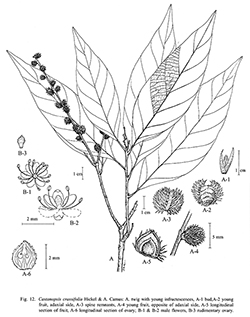e-Flora of Thailand
Volume 9 > Part 3 > Year 2008 > Page 199 > Fagaceae > Castanopsis
9. Castanopsis crassifolia Hickel & A.Camuswfo-0000813310
Bull. Mus. Natl. Hist. Nat. 4: 122. 1928; Fl. Indo Chine 5: 1027. 1930; Barnett, Quer. Rel. Fag. Asia: 437. 1940; C.C.Huang, Y.T.Chang & B.M.Bartol. in C.Y.Wu & P.H.Raven, Fl. China 4: 332. 1999. Fig. 12.
Accepted Name : This is currently accepted.
Description : Tree, 5–20 m high, 50–150 cm girth. Twigs glabrous, lenticellate. Bark greenish-brown, ca 2 cm thick, fissured. Leaves lanceolate rarely ovate, 9–16 by 2–6 cm; base acute, obtuse, usually equal; apex acuminate or caudate; margins entire; coriaceous, glabrous on both surfaces, dark glossy green on the upper surface and pale on the lower; midrib prominent on the lower surface and depressed on the upper; lateral nerves 6–9 pairs, arched but not anastomosing, conspicuous on both surfaces, scalariform veins conspicuous on the lower surface and reticulate veins conspicuous on the upper. Petiole 0.8–1.5 cm, glabrous, black when dry. Inflorescences male and female separate or mixed, terminal and axillary, pubescent. Male inflorescence with few branches, spikelets 4–10 cm long; bracts and bracteoles lanceolate ca 1.5 by 0.3 mm, pubescent outside. Male flowers solitary or in 1–3-flowered cluster; calyx 6-lobed, lobes obovate, ca 2 by 1 mm, glabrous except ciliate margins; stamens 12, ca 3 mm long, glabrous; rudimentary ovary ovoid or conical, ca 0.5 mm in diam., pubescent. Female inflorescence spike 10–20 cm long. Female flowers solitary or in 2–3-flowered cluster, other characters as in male flowers; styles 3; stigmata pointed. Fruits sessile or up to 2 mm long pedicellate, ovoid or obovoid, 2–2.5 cm in diam. (including cupule), often in clusters of 2–3-fruits at intervals with solitary fruits on erect influctescence 10–20 cm long. Cupule completely enclosing the nut except the umbo; wall completely covered by tufted, erect, simple spines (when young with a narrow spineless line from top to base adaxially). Nut 1 per cupule, ovoid or obovoid 1.5–2 by 1–1.5 cm, usually asymmetrical, covered by grey indumentum, then glossy brown except umbo; scar basal; ca 0.5 cm in diam.
Thailand : NORTHERN: Chiang Mai, Chiang Rai, Nan; NORTH-EASTERN: Loei; SOUTH-WESTERN: Kanchanaburi; SOUTH-EASTERN: Chanthaburi, Trat; PENINSULAR: Ranong, Krabi, Pattani.
Distribution : China, Vietnam (type).
Ecology : Tropical evergreen rain forests, lower rain montane pine-oak forests, lower montane rain forests, near streams, 200–1,600 m (most commonly 1,050–1,300 m). Flowering: January–November (most commonly July–December); fruiting: January–December (most commonly March–August).
Vernacular : Ko mu (ก่อหมู), ko laem (ก่อแหลม), ko nam laem (ก่อหนามแหลม), ko nam (ก่อหนาม)(Northern); ko (ก่อ), ko khao (ก่อข้าว), ko haeng (ก่อแห้ง)(Northeastern); ko dueai (ก่อเดือย)(Southeastern); ko rio (ก่อริ้ว), ko mu (ก่อหมู)(Peninsular).
Uses: Nuts edible.

